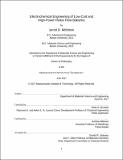| dc.contributor.advisor | Fikile R. Brushett. | en_US |
| dc.contributor.author | Milshtein, Jarrod D. (Jarrod David) | en_US |
| dc.contributor.other | Massachusetts Institute of Technology. Department of Materials Science and Engineering. | en_US |
| dc.date.accessioned | 2017-09-15T14:21:16Z | |
| dc.date.available | 2017-09-15T14:21:16Z | |
| dc.date.copyright | 2017 | en_US |
| dc.date.issued | 2017 | en_US |
| dc.identifier.uri | http://hdl.handle.net/1721.1/111250 | |
| dc.description | Thesis: Ph. D., Massachusetts Institute of Technology, Department of Materials Science and Engineering, 2017. | en_US |
| dc.description | This electronic version was submitted by the student author. The certified thesis is available in the Institute Archives and Special Collections. | en_US |
| dc.description | Cataloged from student-submitted PDF version of thesis. | en_US |
| dc.description | Includes bibliographical references. | en_US |
| dc.description.abstract | Grid-scale energy storage has emerged as a key technology for improving sustainability in the electricity generation sector, and redox flow batteries (RFBs) are promising devices to serve this application. Unlike enclosed batteries, RFBs implement soluble redox active species dissolved in liquid electrolytes, which are stored in large tanks. The electrolyte is pumped through an electrochemical reactor where the active species are oxidized or reduced. The size of the reactor determines the power rating, while the tank volume determines the total energy capacity, enabling scalability unique to this architecture. Recent studies have investigated a number of strategies to reduce RFB system cost. One pathway is to lower the electrolyte cost via decreased chemical costs or increased electrolyte energy density. Low-cost active species, such as redox active organic molecules (ROMs) or abundant inorganics, have gained notoriety. Raising cell potential, by identifying active species with more extreme redox potentials or implementing non-aqueous electrolytes, is an effective approach in reducing RFB cost because higher cell potential will reduce both electrolyte and reactor costs. Engineering the electrochemical stack for lower area-specific resistance (ASR) is another strategy towards dropping reactor cost through increased cell power. The plethora of options for reducing RFB prices can be overwhelming. As such, the present work combines techno-economic (TE) modeling, reactor optimization, and new electrolyte design as a toolbox for developing a low-cost RFB prototype. The TE model first predicts RFB system price as a function of reactor performance and electrolyte materials properties, quantifying metrics to achieve desired price targets. With respect to reactor performance, the TE model identifies a range of viable reactor ASRs, and cell performance is verified experimentally. A parallel modeling study, incorporating electrolyte conductivities, Butler-Volmer kinetics, and transport in porous media, calculates cell polarization. With respect to active material and supporting electrolyte properties, the TE model provides bounded design spaces for cost effective RFBs, guiding material development campaigns. Through collaborations with organic chemists and guided materials selection, new RFB electrolytes are generated and validated in performance prototypes. Ultimately, this thesis utilizes TE modeling to guide reactor optimization and materials development cycles, targeting cost-conscious RFB design. | en_US |
| dc.description.statementofresponsibility | by Jarrod D. Milshtein. | en_US |
| dc.format.extent | 363 pages | en_US |
| dc.language.iso | eng | en_US |
| dc.publisher | Massachusetts Institute of Technology | en_US |
| dc.rights | MIT theses are protected by copyright. They may be viewed, downloaded, or printed from this source but further reproduction or distribution in any format is prohibited without written permission. | en_US |
| dc.rights.uri | http://dspace.mit.edu/handle/1721.1/7582 | en_US |
| dc.subject | Materials Science and Engineering. | en_US |
| dc.title | Electrochemical engineering of low-cost and high-power redox flow batteries | en_US |
| dc.type | Thesis | en_US |
| dc.description.degree | Ph. D. | en_US |
| dc.contributor.department | Massachusetts Institute of Technology. Department of Materials Science and Engineering | |
| dc.identifier.oclc | 1003290360 | en_US |
